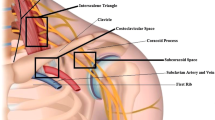Abstract
Background
Eagle’s syndrome is characterized by the symptoms of recurrent throat pain, pharyngeal foreign body sensation, dysphagia, referred otalgia, and neck pain. The treatment for Eagle´s syndrome can be pharmacologically, surgically, or both. The surgical management consists of two major procedures: the transoral approach or the extraoral–cervical approach.
Case Report
A 64-year-old patient with a severe cervical pain on the left side was evaluated with no defined diagnosis. During physical examination, an elongated styloid process could be palpated and with CT scan image, the Eagle´s syndrome diagnosis was done. The patient was successfully submitted to surgical resection of the elongated styloid process on the left side by an extraoral–cervical approach. After 6 months follow-up, the patient referred no symptom after the surgical treatment.
Conclusion
The extraoral/cervical approach is a safe alternative that achieves adequate treatment of Eagle’s syndrome.





Similar content being viewed by others
References
Piagkou M, Anagnostopoulou S, Kouladouros K, Piagkos G (2009) Eagle’s syndrome: a review of the literature. Clin Anat 22:548–558
Eagle W (1937) Elongated styloid process: report of two cases. Arch Otolaryngol 25:584–587
Eagle W (1948) Elongated styloid process: further observations and a new syndrome. Arch Otolaryngol 47(5):630–640
Gozil R, Yener N, Calguner E, Arac M, Tunc E, Bahceliogiu M (2001) Morphological characteristics of styloid process evaluated by computer axial tomography. Ann Anat 183:527–535
Ceylan A, Koybasioglu A, Celenk F, Yilmaz O, Uslu S (2008) Surgical treatment of elongated styloid process: experience of 61 cases. Skull Base 18:289–295
Mortellaro C, Bianucci P, Picciolo G, Vercellino V (2002) Eagle’s syndrome: importance of a corrected diagnosis and adequate surgical treatment. J Craniofac Surg 6:755–758
Beder E, Ozgursoy OB, Ozgursoy SK (2005) Current diagnosis and transoral surgical treatment of Eagle’s syndrome. J Oral Maxillofac Surg 63:1742–1745
Murthy P, Hezerika P, Mary Mahai AS, Kummer HA, Kenneth MP (1990) Elongated styloid process: an overview. Int J Maxillofac Surg 19:230–231
Blomgren K, Qvarnberg Y, Valtonen H (1999) Spontaneous fracture of an ossified stylohyoid ligament. J Laryngol Otol 113:854–855
Bartoni JA, Charlton DG (2001) Stylohyoid syndrome: a case report. Gen Dent 49:512–515
McLeod NMH, Tekeli KM, Cheriyan J (2009) Trigeminal neuralgia: assessment and management by oral and maxillofacial surgeons in the United Kingdom. Br J Oral Maxillofac Surg 47:42–45
Chole R, Patil R, Degwekar SS, Bhowate RR (2007) Drug treatment of trigeminal neuralgia: a systematic review of the literature. J Oral Maxillofac Surg 65:40–45
Prasad KC, Kamath MP, Reddy KJ, Raju K, Agarwal S (2002) Elongated styloid process (Eagle’s syndrome): a clinical study. J Oral Maxillofac Surg 60:171–175
Chuang WC, Short JH, McKinney AM, Anker L, Knoll B, McKinney ZJ (2007) Reversible left hemispheric ischemia secondary to carotid compression in Eagle’s syndrome: surgical and CT angiographic correlation. AJNR Am J Neuroradiol 28:143–145
Correll RW, Jensen JL, Taylor JB, Rhyne RR (1979) Mineralization of the stylohyoid-stylomandibular ligament complex. A radiographic incidence study. Oral Surg Oral Med Oral Pathol 95:11–13
Baddour HM, McAnear JT, Tilson HB (1978) The Eagle’s syndrome: report of a case. Oral Surg Oral Med Oral Pathol 46:486–494
Sivers JE, Johnson GK, Lincoln MS (1985) Diagnosis of Eagle’s syndrome. Oral Med Oral Surg Oral Pathol 59:575
Conflicts of interest
The authors declare that they have no conflicts of interest.
Author information
Authors and Affiliations
Corresponding author
Rights and permissions
About this article
Cite this article
Mayrink, G., Figueiredo, E.P., Sato, F.R.L. et al. Cervicofacial pain associated with Eagle’s syndrome misdiagnosed as trigeminal neuralgia. Oral Maxillofac Surg 16, 207–210 (2012). https://doi.org/10.1007/s10006-011-0276-7
Received:
Accepted:
Published:
Issue Date:
DOI: https://doi.org/10.1007/s10006-011-0276-7




